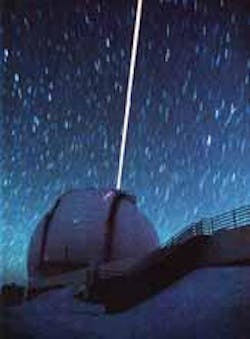
Astronomers have made a leap in ground-based observatory technology with the installation and successful testing of a laser guide-star system at the W. M. Keck Observatory atop Mauna Kea in Hawaii. The effects of Earth's turbulent atmosphere have always limited the resolution of even the largest ground-based observatories. Telescopes above the atmosphere in space are one solution, but very costly and complicated to launch and repair, as shown by the Hubble Space Telescope (HST).
Another established approach, adaptive optics (AO), uses rubbery mirrors and a natural guide star to monitor and correct for atmospheric turbulence. The method enables resolution four times better than that of the HST for wavelengths in the k-band (2 to 4 μm), but requires a star within the field of view, limiting observations to 1% of the sky. To reach 99% of the observable sky, a laser-based artificial guide star can monitor atmospheric turbulence next to any observable object.
In such a system, "the laser is steered literally on top of the object," said Deanna Pennington, project leader for guide star laser systems at Lawrence Livermore National Lab (LLNL; Livermore, CA). The AO system corrects any atmospheric turbulence affecting the laser star and thus also for the target. A 589-nm sodium filter removes the laser light from the observational data.
A better guide star
The Keck laser guide-star system was designed by LLNL for use as an artificial laser beacon with the existing AO system on the Keck II telescope. A similar artificial guide-star system is in place at the Lick Observatory (Flagstaff, AZ), but the Keck version incorporates additional pump lasers, five times as many diagnostics, and is remotely operable from Keck headquarters at 2900 ft or from LLNL, says Pennington.
Using technology developed by the atomic-laser vapor isotope separation (AVLIS) program at LLNL, the laser system consists of six 60-W frequency-doubled Nd:YAG pump lasers providing 360 W of power, fiber-coupled to a dye laser master oscillator, two amplifiers, a dye pumping system, optical delivery telescopes, and laser diagnostic systems. Ethanol dye solution is pumped through dye lines to the main laser on the telescope frame, an 18-W, 26-kHz pulsed dye laser system operating at 589 nm (see figure).
The pump lasers and dye system components are located in a room on the floor of the Keck II telescope dome to minimize vibration. The low-power dye light and high-power Nd:YAG light are transported through fiberoptic cables to the dye laser components mounted on the telescope. The dye laser preamplifier and power amplifiers, as well as the optical transport telescope and diagnostic packages are also mounted right on the support frame of the 10-m telescope. The beam is then expanded from 3 to 500 mm by a projection telescope out of the dome.
"The main concern for this laser system is safety—protection of personnel and equipment," says Jason Chin, an engineer at Keck. Because of the high flammability of the dye solution being pumped right up to the telescope, extreme caution was taken to prevent leaks. Sensors inform the main PLC control system to shut down the laser in case of a leak.
On Dec. 23, 2001, the laser was successfully propagated to the sodium layer of the mesosphere 95 km above Earth, reports the Keck/LLNL team. The system passed several 40-hr performance milestones in the lab, consistently delivering 16 to 20 W. Without optimization, the system delivered 17 W of power, and produced a 9.5-magnitude star with an angular resolution of 1.4 arc seconds. After optimization, the expected size of the laser spot will be 0.6 arc seconds.
"The Keck laser guide-star system will effectively access about 50% of the sky due to observatory and FAA limits," says Pennington. A beam avoidance traffic control system was integrated to ensure the beam does not interfere with other observatories on Mauna Kea. Approval from the FAA and the Space Command Clearing House ensured the safety of aircraft and satellites from stray laser light. Activation and integration of the laser with the AO system are expected in June 2002, barring unforeseen delays, particularly that of weather. Characterization and testing of the laser system in early 2002 was delayed for weeks because of "the worst storm in 80 years" on Mauna Kea, said Pennington.

Valerie Coffey-Rosich | Contributing Editor
Valerie Coffey-Rosich is a freelance science and technology writer and editor and a contributing editor for Laser Focus World; she previously served as an Associate Technical Editor (2000-2003) and a Senior Technical Editor (2007-2008) for Laser Focus World.
Valerie holds a BS in physics from the University of Nevada, Reno, and an MA in astronomy from Boston University. She specializes in editing and writing about optics, photonics, astronomy, and physics in academic, reference, and business-to-business publications. In addition to Laser Focus World, her work has appeared online and in print for clients such as the American Institute of Physics, American Heritage Dictionary, BioPhotonics, Encyclopedia Britannica, EuroPhotonics, the Optical Society of America, Photonics Focus, Photonics Spectra, Sky & Telescope, and many others. She is based in Palm Springs, California.